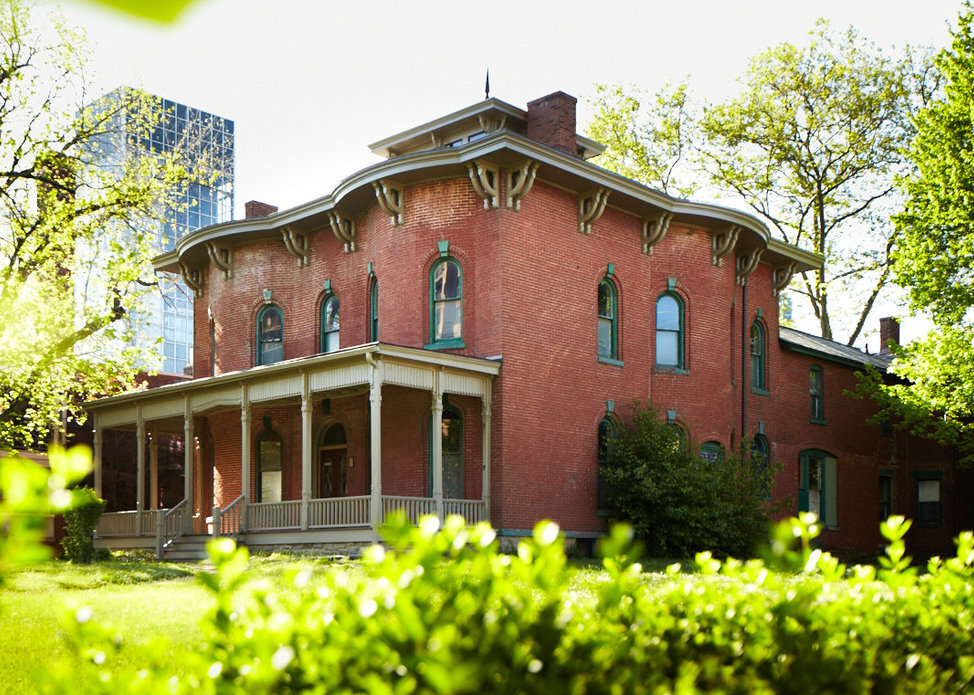Late last year, University Circle Inc. (UCI) completed the first phase of the renovation and restoration of the historic Cozad-Bates House. The house is the only pre-Civil War building remaining in University Circle. A new interpretive center will open in 2021 with indoor exhibits and outdoor installations that highlight this area’s history as a center of anti-slavery activism and honor those seeking freedom.
“The Cozad-Bates House has been a long-term, high impact project and a labor of love for UCI that started more than a decade ago,” said Chris Ronayne, president of UCI. “We are excited to be able to share this incredible building with the public and tell the story of the Underground Railroad in Cleveland.”
The Cozad-Bates House was built in 1853, with additions added in the 1860s and 1872. The new interpretive center reflects the legacy of Cleveland’s anti-slavery activists who lived in the area and aided freedom seekers through the Underground Railroad network in Cleveland, code named “Hope.”
Together with leading interpretive partner Western Reserve Historical Society and long-time community partner Restore Cleveland Hope, UCI established the Cozad-Bates House Community Advisory Committee, a group of community activists, educators, and historians, to guide development of the Interpretive Center’s content and educational curriculum. Greg Deegan, Co-Director of Teaching Cleveland, became an integral part of the project team when he joined UCI as Community Education Director in 2017.
Working with the Western Reserve Historical Society and Community Advisory Committee, Deegan oversaw the development of the educational program “Cleveland Underground: Resistance and Compliance.” Developed for students grades 6 through 12, the program asks students to investigate Cleveland’s role in the Underground Railroad and explore issues of personal choice and activism. Examining two historic local court cases, students examine the legal issues of American slavery and its effect on Northeast Ohioans, discuss concepts such as personal choice and consequences, and draw connections about the lasting impact of slavery, racism, and injustice. Through facilitated dialogue, students explore their own viewpoints on contemporary social issues and learn how to articulate their views in an effective manner. Western Reserve Historical Society will offer this as an in-person program, incorporating visits to both the Cozad-Bates House and the Cleveland History Center, after the pandemic.
UCI welcomed the first visitors to the new Cozad-Bates House Interpretive Center virtually in 2020 through a live tour. An incredible 3D virtual tour is also now available, allowing users to explore the exhibit narrative through select photographs, maps, and media. The interior of the Cozad-Bates House Interpretive Center features three distinct spaces, each with its own story and purpose: the Gund Foundation West Wing, Cleveland Foundation East Wing, and the KeyBank Community Room. The West Wing exhibits set both the national and local context for slavery in the years leading up to the Civil War. The East Wing highlights stories of local anti-slavery activists and freedom seekers, such as Sarah Lucy Bagby Johnson, a Cleveland resident who escaped slavery only to be returned to Virginia under the Fugitive Slave Act. The KeyBank Community Room connects past to present with programming that outlines how the impacts of slavery are still seen in today’s social issues through an exploration of the 13th,14th, and 15th amendments, developed by Case Western Reserve University’s Social Justice Institute. The Community Room also provides a future space for small group discussions and programming led by docents and community partners.
The preserved front lawn of the Cozad-Bates House is now transformed into a new cultural open space which will open to the public this spring. The outdoor portions of the exhibit feature an interpretive walkway that combines art and landscape to further highlight the people and places of the Underground Railroad network in Cleveland. Thoughtful features include educational signage shaped like the arched windows of the home itself. That signage is also indigo-colored, a reference to one of the staple crops of the exploitive slave economy. Many of the plants used in the landscaping are gnarly or spiky, reflecting a difficult history. Some of these plants are edible or carry medicinal properties that evoke the hope that the land itself might offer support for freedom seekers on their long and dangerous journey. Visitors can find quotes from local and national leaders throughout the landscape, along with an installation of the Big and Little Dipper that recognizes the North Star as the guiding light followed by fugitive slaves toward freedom.
For more information on the Cozad-Bates House Interpretive Center, including the link to the 3D virtual tour, click here.
